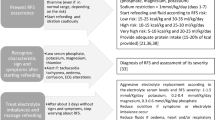Abstract
Bile acid deconjugation was assessed by measuring specific activity of expired14CO2 after the oral administration of cholyl-glycine-1-14C in 17 cases of intestinal obstruction, i.e. 15 mechanical and two paralytic.
In the former, nine cases were operated and the remaining six cases were managed by the conservative treatment.
Cumulative output of14CO2 in breath for six hours before the treatment was 40.20=11.30 (mean±SEM) (control 2.96±1.16) but decreased to 6.86±3.64 after the treatment.
Enteric bacteria capable of splitting amino moiety of the conjugated bile acid were found to be present more than 105/ml. in the obstructed bowel content. Cumulative output of14CO2 in breath for six hours in two paralytic ileus was lower than in controls. Deconjugated bile acid reported to inhibit water and electrolytes absorption in the small intestine may play an important role in fluid retention in intestinal obstruction.
Similar content being viewed by others
References
Abt, A.F. and Con Schuchung, S.L.: Fat utilization test in disorders of metabolism. A new diagnostic methods applied to patients suffering with malabsorption syndrome, chronic pancreatitis and arteriosclerotic cardiovascular disease.Bull. Johns Hopkins Hosp. 119: 316–330, 1966.
Adachi, K.: Experimental studies in acute strangulated intestinal obstruction in germ free mice,J Jap. Surg. Ass. 73: 678–689, 1972.
Andreasen, P.B.: Clearance of antipyrine-dependence of quantitative liver function,Europ. J. Clin. Invest. 4: 129–134, 1974.
Benders, S., Sauer, H. and Hoffmann, K.: Kinetics of bile acid metabolism in experimental blind loop syndrome.Gut. 16: 927–931, 1975.
Binder, H.J.: Bile acid inhibition of intestinal anaerobic organisms,Am. J. Clin. Nutr. 28: 119–125, 1975.
Cohn, I.: Stragulation obstruction of the effects of pre and post operative antibacterial agents,Ann. Surg. 138: 748–758, 1953.
Floch, M.H.: Bile acid inhibition of the intestinal microflora function—a function for simple bile acid?,Gastroent. 61: 228–233, 1971.
Fromm, H. and Hofmann, A.F.: The rapid detection of altered bile acid metabolism; a new test for the diagnosis of ileal dysfunction or bacterial overgrowth,Gastroent. 60: 663, 1971.
Fukushima, T. and Tsuchiya, S.: Bile acid metabolism in the intestinal disorders; bile acid deconjugation by breath analysis test,Geka (Surgery) 37: 1045–1049, 1975.
Harries, J.T. and Sladen, G.E.: Effects of bile acids on small intestinal absorption of glucose, water and sodium,Gut 12: 855–861, 1971.
Hattori, H.: Immunologic study of enteric bacteria in body fluid and change of enteric bacteria in intestinal obstruction,J. Jap. Surg. Ass. 67: 1207–1222, 1967.
Hepner, G.W.: Breath analysis: gastroenterological applications,Gastroent. 67: 1250–1256, 1974.
Iwama, A.: Clinical and experimental studies on acute strangulated intestinal obstruction —special reference of the bacterial lethal factor,J. Jap. Surg. Ass. 76: 405–419, 1975.
James, O.F.W., Agnew, J.E. and Bouchier, I.A.D.: Assessment of the C14-glycocholic acid breath test,Brit. Med. J. 3: 191–195, 1973.
Levitt, M.D. and Donalson, R.M.: Use of respiratory hydrogen (H2) excretion to detect carbohydrate malabsorption,J. Lab. Lin. Med. 75: 937–945, 1970.
Morton, J.H.: The use of aureomycin in experimental intestinal obstruction,Ann. Surg. 134: 1007–1012, 1951.
Myerson, R.M.: Detection of deconjugation of bile salts by measurement of the specific activity of14CO2 in expired air,Am. J. Med. Sci. 267: 35–42, 1974.
Schwabe, A.D.: Cozzetts, F.J., Benett, L.R.: Estimation of fat absorption by monitoring a radioactive fat,Gastroent. 42: 285–291, 1962.
Sherr, H.P.: Detection of bacterial deconjugation of bile acid by a convenient analysis technic,New Eng. J. Med. 285: 656–661, 1971.
Tabaqchali, S. and Booth, C.C.: Jejunal bacteriology and bile salts metabolism in patients with intestinal malabsorption,Lancet 2: 19–25, 1966.
Yale, C.E. and Altemeier, W.A.: Intestinal obstruction in germ free rats,Arch. Surg. 91 241–247, 1965.
Author information
Authors and Affiliations
Rights and permissions
About this article
Cite this article
Fukushima, T., Ishiguro, N., Tsujinaka, Y. et al. Bile acid deconjugation in intestinal obstruction studied by breath test. The Japanese Journal of Surgery 7, 73–81 (1977). https://doi.org/10.1007/BF02469389
Received:
Issue Date:
DOI: https://doi.org/10.1007/BF02469389




